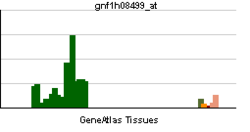- DNER
-
Delta/notch-like EGF repeat containing Identifiers Symbols DNER; UNQ26; bet External IDs OMIM: 607299 MGI: 2152889 HomoloGene: 26722 GeneCards: DNER Gene Gene Ontology Molecular function • transmembrane receptor activity
• Notch binding
• calcium ion binding
• protein binding
• clathrin bindingCellular component • early endosome
• plasma membrane
• integral to membrane
• dendrite
• neuronal cell bodyBiological process • neuron migration
• endocytosis
• Notch signaling pathway
• Notch receptor processing
• synapse assembly
• central nervous system development
• glial cell differentiation
• skeletal muscle fiber developmentSources: Amigo / QuickGO RNA expression pattern 
More reference expression data Orthologs Species Human Mouse Entrez 92737 227325 Ensembl ENSG00000187957 ENSMUSG00000036766 UniProt Q8NFT8 Q8JZM4 RefSeq (mRNA) NM_139072 NM_152915.1 RefSeq (protein) NP_620711 NP_690879.1 Location (UCSC) Chr 2:
230.22 – 230.58 MbChr 1:
84.37 – 84.69 MbPubMed search [1] [2] Delta and Notch-like epidermal growth factor-related receptor is a protein that in humans is encoded by the DNER gene.[1][2][3]
References
- ^ Eiraku M, Hirata Y, Takeshima H, Hirano T, Kengaku M (Jul 2002). "Delta/notch-like epidermal growth factor (EGF)-related receptor, a novel EGF-like repeat-containing protein targeted to dendrites of developing and adult central nervous system neurons". J Biol Chem 277 (28): 25400–7. doi:10.1074/jbc.M110793200. PMID 11950833.
- ^ Nishizumi H, Komiyama T, Miyabayashi T, Sakano S, Sakano H (May 2002). "BET, a novel neuronal transmembrane protein with multiple EGF-like motifs". Neuroreport 13 (6): 909–15. doi:10.1097/00001756-200205070-00035. PMID 11997712.
- ^ "Entrez Gene: DNER delta/notch-like EGF repeat containing". http://www.ncbi.nlm.nih.gov/sites/entrez?Db=gene&Cmd=ShowDetailView&TermToSearch=92737.
Further reading
- "Toward a complete human genome sequence.". Genome Res. 8 (11): 1097–108. 1999. doi:10.1101/gr.8.11.1097. PMID 9847074.
- Strausberg RL, Feingold EA, Grouse LH, et al. (2003). "Generation and initial analysis of more than 15,000 full-length human and mouse cDNA sequences.". Proc. Natl. Acad. Sci. U.S.A. 99 (26): 16899–903. doi:10.1073/pnas.242603899. PMC 139241. PMID 12477932. http://www.pubmedcentral.nih.gov/articlerender.fcgi?tool=pmcentrez&artid=139241.
- Clark HF, Gurney AL, Abaya E, et al. (2003). "The secreted protein discovery initiative (SPDI), a large-scale effort to identify novel human secreted and transmembrane proteins: a bioinformatics assessment.". Genome Res. 13 (10): 2265–70. doi:10.1101/gr.1293003. PMC 403697. PMID 12975309. http://www.pubmedcentral.nih.gov/articlerender.fcgi?tool=pmcentrez&artid=403697.
- Gerhard DS, Wagner L, Feingold EA, et al. (2004). "The status, quality, and expansion of the NIH full-length cDNA project: the Mammalian Gene Collection (MGC).". Genome Res. 14 (10B): 2121–7. doi:10.1101/gr.2596504. PMC 528928. PMID 15489334. http://www.pubmedcentral.nih.gov/articlerender.fcgi?tool=pmcentrez&artid=528928.
- Hillier LW, Graves TA, Fulton RS, et al. (2005). "Generation and annotation of the DNA sequences of human chromosomes 2 and 4.". Nature 434 (7034): 724–31. doi:10.1038/nature03466. PMID 15815621.
- Kimura K, Wakamatsu A, Suzuki Y, et al. (2006). "Diversification of transcriptional modulation: large-scale identification and characterization of putative alternative promoters of human genes.". Genome Res. 16 (1): 55–65. doi:10.1101/gr.4039406. PMC 1356129. PMID 16344560. http://www.pubmedcentral.nih.gov/articlerender.fcgi?tool=pmcentrez&artid=1356129.
- Ramachandran P, Boontheung P, Xie Y, et al. (2006). "Identification of N-linked glycoproteins in human saliva by glycoprotein capture and mass spectrometry.". J. Proteome Res. 5 (6): 1493–503. doi:10.1021/pr050492k. PMID 16740002.
Categories:- Human proteins
- Chromosome 2 gene stubs
Wikimedia Foundation. 2010.
